A deep dent in your car door can be an eyesore and significantly impact your vehicle’s aesthetics. Fortunately, there are various methods to repair such dents, ranging from DIY solutions to professional services. This guide will equip you with the knowledge and techniques to tackle this common automotive issue effectively.
Understanding Dent Removal Methods
Dent removal techniques can be broadly categorized into two types: pulling and filling. Each method has its own advantages and limitations:
Pulling
- How it works: This method utilizes specialized tools to gently pull the dent back into its original shape.
- Advantages: Often a more cost-effective solution, especially for smaller dents.
- Disadvantages: May not be effective for deep or complex dents, potentially leaving minor imperfections.
Filling
- How it works: This method involves applying a filler material, typically a type of body filler, to the dent, followed by sanding and painting to create a smooth surface.
- Advantages: Can effectively repair deep and complex dents, leaving a smooth and uniform finish.
- Disadvantages: More labor-intensive, requiring specialized tools and skills.
DIY Dent Removal Techniques for Shallow Dents
If the dent is relatively shallow and doesn’t involve major metal deformation, you may consider attempting a DIY fix:
- Boiling Water Method: This method utilizes heat expansion to reshape the dent. Pour boiling water directly onto the affected area and wait for it to cool down. This can help stretch the metal and partially reduce the dent.
- Vacuum Suction Method: This method uses a vacuum to pull the dent out. While effective for small dents, it may require professional tools.
- Glue Pulling Method: This technique uses special glue to attach a pulling tab to the dent and then pulls it out. It’s a widely used method for small dents, but may require some practice.
However, it’s crucial to note that these DIY techniques are not always effective, especially for deep or complex dents.
“It’s crucial to remember that DIY methods are not suitable for all dents. Deep dents or those involving damage to the underlying structure require professional expertise,” advises renowned automotive technician, Michael Johnson.
When to Seek Professional Help
While DIY solutions can be helpful, sometimes professional assistance is necessary. You should consult a professional if:
- The dent is deep or complex: Professional tools and techniques are often required for such cases.
- The dent involves significant damage: If the dent is accompanied by metal deformation, cracks, or holes, professional repair is recommended.
- You lack the necessary skills or tools: Attempting a repair without proper knowledge or equipment can lead to further damage.
Professional Dent Removal Techniques
Professionals use a variety of techniques for dent removal:
- Paintless Dent Removal (PDR): This technique is considered the gold standard for dent removal. It involves using specialized tools to gently massage the dent back into shape without the need for filler or repainting.
- Body Filler Repair: For deep dents, body filler is applied to fill the dent, followed by sanding and painting to restore the surface.
- Dent Repair Using Heat and Pressure: This technique uses heat to soften the metal and pressure to reshape the dent.
Cost Considerations
The cost of fixing a deep dent in a car door varies depending on the severity of the damage, the chosen repair method, and the location. Generally, DIY techniques are the most cost-effective, while professional repairs, especially PDR, can be more expensive.
Choosing the Right Method
The best approach depends on the severity of the dent, your budget, and your comfort level with DIY repairs. If you’re unsure, it’s always advisable to consult a professional for an assessment.
“Don’t hesitate to seek professional advice when faced with a deep dent. A qualified technician can guide you towards the most suitable repair method and avoid potential complications,” emphasizes experienced mechanic, Sarah Miller.
Preventing Future Dents
- Park Carefully: Avoid parking in tight spaces or near potential hazards.
- Use Car Covers: Protect your vehicle from debris and weather damage with a car cover.
- Maintain Clear Surroundings: Ensure your car is free of obstacles before entering or exiting.
 Car Parked Safely in a Garage
Car Parked Safely in a Garage
FAQs
Q1: Can I fix a deep dent myself?
A: While DIY methods exist, they are not effective for deep dents. Seek professional assistance for best results.
Q2: What is the most affordable way to fix a dent?
A: DIY methods are generally the most budget-friendly, but they may not produce the desired results.
Q3: How long does it take to fix a deep dent?
A: The time required varies depending on the chosen method. DIY repairs may take several hours, while professional repairs can be completed in a few hours or days.
Q4: Will a repaired dent affect my car’s resale value?
A: A professionally repaired dent should not significantly affect your car’s resale value.
Q5: Can I prevent dents from happening in the first place?
A: While you can’t completely eliminate the risk, you can significantly reduce the chances of dents by following the tips mentioned above.
If you’re facing a deep dent in your car door, don’t despair! With the right approach and guidance, you can restore your vehicle to its former glory. For further assistance and expert advice, contact [fix hole in car reservoir](https://autotippro.com/fix-hole-in-car-reservoir/) or call us at +1 (641) 206-8880.






Leave a Reply